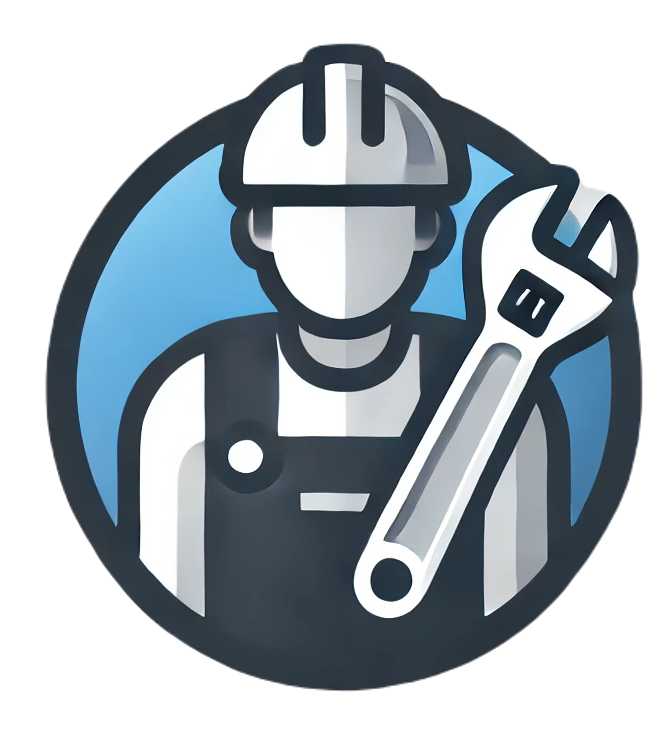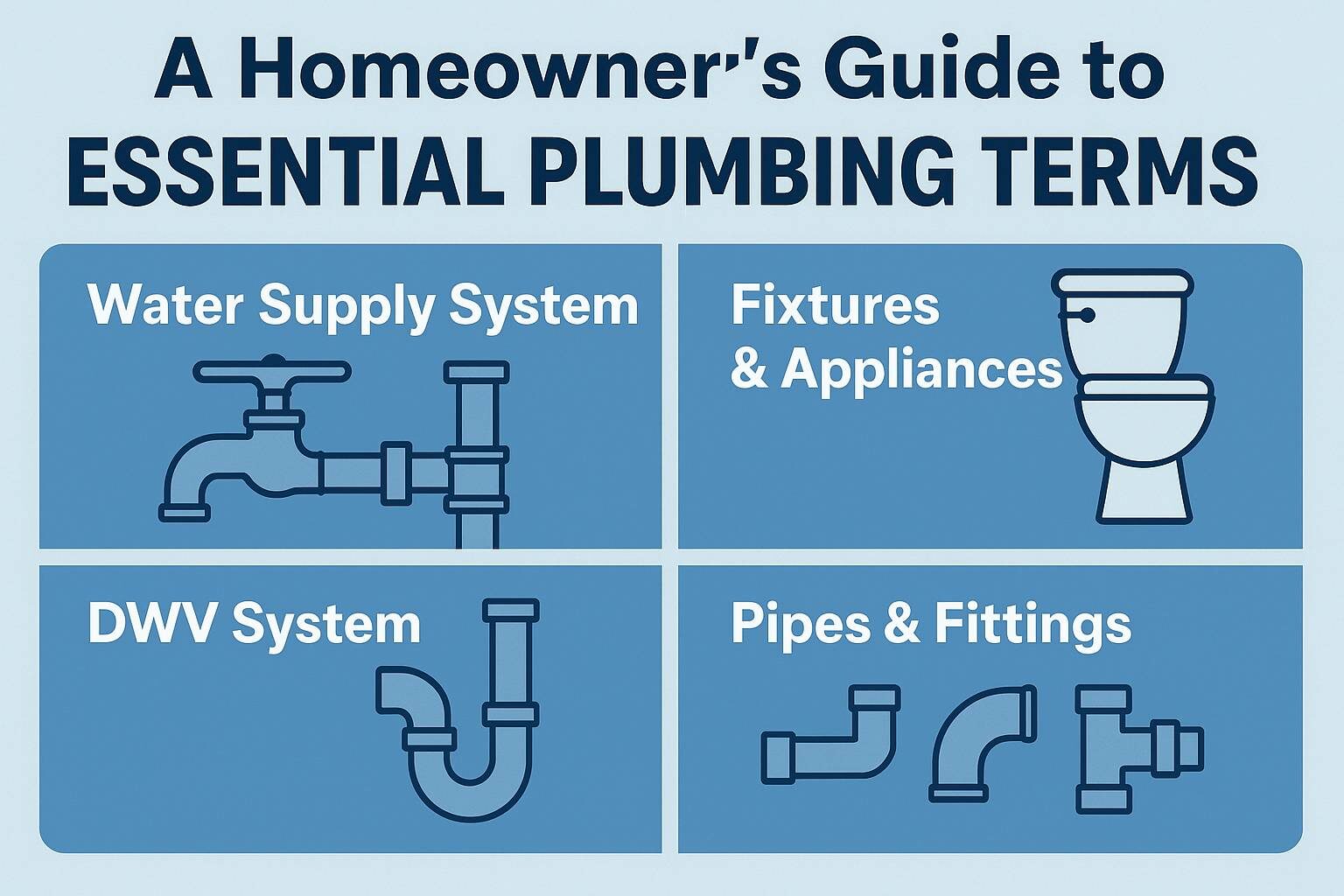🏠 A Homeowner’s Glossary of Essential Plumbing Terms
Understanding the System That Keeps Your Home Running
Every home relies on a hidden network of pipes, valves, and fixtures working together to deliver clean water and safely remove waste. Most homeowners never think about this system—until something leaks, clogs, or bursts.
This guide gives you a clear overview of how plumbing systems work, what key terms mean, and how to speak the same language as your plumber. Use it as a reference to troubleshoot minor issues, prepare for maintenance, or simply understand what’s happening behind your walls.
1. The Big Picture: How Your Plumbing System Works
Every plumbing system does two main things:
- Brings clean, potable water in for drinking, bathing, and cleaning.
- Removes used or contaminated water out through the drainage and venting system.
These two halves—the water supply system and the drainage, waste, and vent (DWV) system—work together to keep your home healthy and functional.
Key Concepts
- Plumbing: The complete network of pipes, fixtures, valves, and fittings that supply water and remove waste in a building.
- Potable Water: Water safe for drinking and personal use, approved by health authorities.
- Sewage: Wastewater containing human or organic waste from toilets, sinks, and appliances.
- Drainage System: The network that removes wastewater, rainwater, and sewage from the property.
- Plumbing Code: Local or national regulations that define safe design and installation standards.
💡 Tip: Homes without access to a public sewer system rely on a septic system—a private on-site method for wastewater treatment and disposal.
2. Getting Water Where You Need It: The Water Supply System
The water supply system delivers clean, pressurized water from the municipal water main or your private well to every fixture in your home. It relies on pipes, valves, and pressure control devices to maintain steady, safe water flow.
| Term | What It Means |
|---|---|
| Water Main | The large underground pipe that supplies municipal water to your neighborhood. |
| Service Pipe | The connection between the water main and your home’s plumbing. |
| Pressure | The force pushing water through pipes, usually measured in PSI (pounds per square inch). |
| Pressure Regulator Valve (PRV) | A valve that reduces incoming water pressure to a safe level (usually 40–80 PSI). |
| Valve | A device that starts, stops, or adjusts water flow. |
| Faucet | The fixture that releases water for use (e.g., kitchen sink, shower head). |
| Water Heater | The appliance that heats water for bathing, laundry, and cleaning. |
Common Valve Types
- Gate Valve: Opens and closes water flow fully—best for shutoff use, not for flow control.
- Globe Valve: Regulates (throttles) flow—ideal for adjusting water output.
- Check Valve: Prevents backflow, allowing water to move in only one direction.
- Backflow Preventer: A specialized safety device that stops contaminated water from reversing into your clean supply.
💡 Homeowner Tip: Learn the location of your main shutoff valve, usually near where the water line enters the home or by your water meter. Turning it off can prevent thousands in water-damage repairs during emergencies.
3. Everyday Fixtures & Appliances
Plumbing fixtures are where you interact with the water system—the points of use for clean water and entry points for wastewater.
| Fixture | Description |
|---|---|
| Toilet (Water Closet): | Disposes of human waste into the drainage system. |
| Sink / Lavatory: | Used for washing hands, dishes, or food prep. |
| Bathtub / Shower Head: | Delivers water for bathing. |
| Hose Bibb: | Outdoor faucet for connecting garden hoses. |
| Urinal: | Fixture designed for liquid waste (mostly commercial). |
| Dishwasher / Washing Machine: | Appliances that use and discharge water automatically. |
| Refrigerator Ice Maker: | Connects to a small water line for ice and drinking water. |
💧 Water Quality Add-Ons:
Many homes also have water softeners, filtration systems, or whole-house filters to reduce minerals, chlorine, and contaminants.
4. Where It All Goes: The Drainage, Waste, and Vent (DWV) System
Once water is used, it becomes wastewater. The DWV system removes this wastewater and sewer gas using gravity, air pressure, and proper venting.
| Component | What It Does | Why It Matters |
|---|---|---|
| Drain | Carries used water away from fixtures. | Prevents pooling and backups. |
| Trap | Holds a small water seal below each drain. | Blocks sewer gas from entering your home. |
| Vent Pipe | Allows air into the system. | Prevents vacuum suction that could empty traps and cause gurgling drains. |
| Stack | Vertical pipe connecting multiple drains. | Main route for waste and venting through the roof. |
| Cleanout | Access point for removing clogs in the main drain. | Critical for maintenance and professional service. |
| Building Drain | Horizontal pipe that collects waste from the whole house. | Directs flow to the sewer line or septic system. |
| Building Sewer / Lateral: | Connects your home’s drain to the municipal sewer or septic tank. | Final transport of all wastewater. |
💡 Tip: If you notice a foul odor indoors, one of your traps may be dry. Run water in seldom-used fixtures or floor drains to restore the water seal.
5. The Building Blocks: Pipes, Fittings, and Joining Methods
All plumbing systems are built from pipes and fittings—components that guide and connect the water flow.
Common Pipe Materials
| Material | Typical Use | Key Notes |
|---|---|---|
| PEX (Cross-Linked Polyethylene) | Modern supply lines | Flexible, easy to install, and freeze-resistant. |
| Copper Pipe | Water supply lines | Long-lasting and corrosion-resistant. |
| PVC (Polyvinyl Chloride) | Drain, waste, vent piping | Lightweight, easy to cut and glue. |
| ABS (Acrylonitrile-Butadiene-Styrene) | Drainage and vent systems | Black plastic alternative to PVC. |
| Cast Iron | Older or commercial drainage systems | Extremely durable but heavy. |
| Galvanized Steel | Older supply systems | Prone to corrosion—consider replacement if present. |
Common Fittings
| Fitting | Purpose |
|---|---|
| Elbow (Ell): | Changes direction (often 45° or 90°). |
| Tee: | Splits a single line into two. |
| Coupling: | Connects two straight pipes. |
| Reducer/Bushing: | Joins pipes of different sizes. |
| Cap: | Seals the end of a pipe. |
| Flange: | Flat fitting that secures fixtures (like toilets). |
| Nipple: | Short threaded pipe used between fittings. |
Joining Methods
- Soldering: Uses melted metal (solder) to seal copper joints.
- Brazing: Creates stronger metal bonds at higher temperatures.
- Welding: Fuses metals directly—common in industrial settings.
- Threading: Screws fittings together (often with Teflon tape).
- Gluing / Solvent Welding: Bonds PVC or ABS pipes using primer and cement.
6. Protecting Your Home: Safety, Maintenance & Support Systems
Understanding a few more systems helps you maintain a healthy, efficient plumbing network.
| System / Component | What It Does |
|---|---|
| Sump Pump: | Removes groundwater from basements and crawlspaces, preventing flooding. |
| Water Pressure Gauge: | Measures water pressure; ideal for testing municipal or well supply. |
| Cross-Connection: | A point where potable and non-potable water might mix—backflow preventers stop this. |
| Expansion Tank: | Installed near water heaters to handle thermal expansion pressure. |
| Water Hammer Arrestor: | Absorbs shock when valves close suddenly, preventing pipe noise. |
💡 Maintenance Tip: Every 6–12 months, test your sump pump, inspect shutoff valves, and drain your water heater to remove sediment buildup.
Final Word: Be an Informed Homeowner
You don’t need to be a plumber to understand your home’s plumbing—but knowing the basics can help you spot problems early, communicate clearly with professionals, and make smart repair decisions.
By learning key terms like PEX, backflow preventer, trap, and cleanout, you’ll not only improve your home maintenance skills—you’ll protect your investment and your family’s health.
✅ Quick Homeowner Checklist
- Locate your main water shutoff valve and label it.
- Check your water pressure (ideal range: 40–80 PSI).
- Flush seldom-used drains to keep traps filled.
- Inspect hoses and valves on washing machines and dishwashers yearly.
- Schedule a plumbing inspection every 2–3 years, especially for older homes.
- Know your materials—replace old galvanized or corroded pipes when possible.
- Test your sump pump and cleanout access before storm season.

